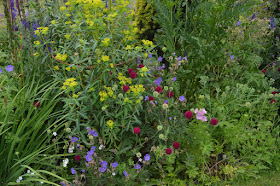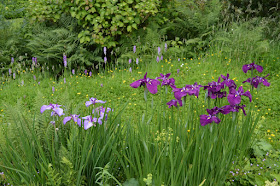At last we have gotten
the meadow cut. This is an annual nightmare, as it is for a lot of
other owners of small patches of grassland. In the end a local
contractor, Phil, came to the rescue, borrowing a huge John Deere
tractor and flail off a farmer friend to come and do it for us. We're
very grateful!
We are typical of many
of a new demographic in the British countryside, the micro-landowner,
with just a few acres – we have about 3+ acres of wildflower meadow
to cut. Ours is very bio-diverse, indeed some of it quite
exceptionally interesting, a rare survival of a pre-intensification
grassland. But getting it cut, let alone doing what we should be
doing, getting it cut and raking off the cut grass as hay, is always
really difficult. The problems of doing so bring one up against two
things: the problems of actually achieving good medium-scale habitat
management, and the realities of global agriculture.
In the past, a local
farmer would be happy to come and cut the grass for hay, problem
solved. But no-one wants hay anymore, although horses are happy to
eat it, silage is better for most animals and a lot easier for the
farmers – apart from anything else, hay has to be left to dry,
which is not always possible in the climate of west Britain.
(Silage, by the way, is grass cut young and lush and fermented to make a very digestible animal feed which can be kept for up to two years.)
Not any more. Coming
and cutting small acreages is simply not worth it for farmers. The
last two years we had a silage cut, which is done in June when the
grass is lush, but it is not worth it for them to come back – it
involved a small army of huge machinery to come quite a few miles.
Anyway a silage cut removes the grass before a lot of wildflowers
have performed, let alone seeded. In many places it can, I believe,
be a disaster for biodiversity. See what I wrote about it in Austria a few years ago. But it did remove the nutrients for those years
– as we all know now, removing grass/herbage removes nutrients, so
reducing the nutrient level of the soil, which reduces grass growth
and so therefore encourages biodiversity.
You would think that
one or two of the local farmers might have cottoned on to the fact
that the area now has lots of people like us who want small scale
cuts done, and come and cut them at a premium price. Not a bit of it.
Like many semi-marginal agricultural areas most of them are the ones
who haven't had the initiative to go and do something else; they seem
completely stuck in the same old way of doing things: overgrazing the
land with EU-subsidised sheep and mechanically producing silage, preferably from monocultures of ryegrass. This
is one of the problems with small-scale farming – most of those who
practice it never made an active choice to do it, they are just
following in their fathers' and grandfathers' footsteps. There is
the occasional bright spark who has realised that this is all completely uneconomic and diversified into the new rural
economy – niche farming and food processing: artisan cheeses, fruit cordials, single-variety cider etc. Fortunately this does seem to be growing in Herefordshire.
Even if some of the
local agricultural community did get the initiative to offer small
meadow management services, they would face the next problem – the
'kit'. All modern agricultural machinery in Britain is vast, made for
the plains of Kansas, or at least Lincolnshire - the places where a totally different landscape actually feeds us. Agriculture is
subject to an elementary economic law – the Law of Diminishing
Returns, which basically means that scale is everything (except if
you can buck the Law by developing a niche market, which is
essentially what so-called 'organic' production, farm shops and food
fairs are all about). The Law means that there is no longer a market
for small or medium-sized tractors etc, so anyone who enters the
small acreage market inevitably has to be a vintage tractor and farm
machinery addict.
One answer, in the
neighbouring county has been the Monmouthshire Meadows Group whose
mission statement declares "Our aim is to conserve and restore flower rich grasslands in Monmouthshire by enabling members to manage their own fields and gardens effectively". Their website lists
contractors for all sorts of wildflower meadow conservation services
and apparently they did club together a few years ago to buy an
Austrian small cutter and baler. There is talk of something being set
up in Herefordshire, which is very good news indeed.
So, what is so special
about our bit of grassland?
We were here for a
year before we realised just how special one bit of our land was –
it had an incredibly dense sward with very little grass, but instead
was made up of two wildflowers – fleabane and silverweed, plus
rushes and sedges, plus a whole lot of other wildflowers. There were
a few orchids, three the first year. Our neighbour (a v.
old-fashioned smallholder) had sheep on it, we gradually reduced
them, and as we did so, the flora burgeoned – we now have thousands
of spotted orchids. As time has gone on, we have seen this very
interesting flora slowly spread – it is actually a flora which is
more typical of 'dune slacks' – wet areas of sand dunes, on the
south Wales coast, than anything else I have seen around here. In
parts I am reminded of alpine herbfield – as there is so little
grass.
I suspect that there
was once an awful lot more of this kind of biodiverse grassland
around. I also suspect that if the amount of sheep-grazing were
reduced we might seen the development of a lot more. Sheep are the
curse around here – the deforested scenery of much of Wales and the
borders is constantly nibbled to within a millimetre of its life by
them. Unlike cattle, which are no longer rough grazed in the area
(what Americans call ranching) they tiptoe around bracken, which
continues its onward march, smothering vast areas. The sooner we give
up subsidising farmers to keep these biodiversity-gobbling beasts in
marginal areas like this, the better. A landscape of woodland
(economic use = biomass?) and small patches of economically useless
but biodiverse grassland like ours, would be much more preferable.
* * * * *
If you like this blog, why not check out my e-books, which are round-ups of some writing I did for Hortus magazine back in the early 2000s, along with an interview with the amazing Beth Chatto. You can read them on Kindle, or Kindle packages for smartphones or the computer. You can find them on my Amazon page here. You will also find my soap opera for gardeners - currently running at eight episodes.
SUPPORT THIS BLOG
I write this blog unpaid (of course)
and try to do two postings a month, to try to provide the garden,
wildflower and plant-loving community with information, inspiration
and ideas. Keeping it coming is not always easy to fit into a busy
working life. I would very much appreciate it if readers would 'chip
in' (as we say in England) and provide a little financial support.
After all, you pay for magazines and books, and it is only for
historical reasons that the internet is free. Some money coming in
will help me to improve quality and frequency, and to start to
provide more coherent access to hard information, which I know is
what a lot of you really want. So – please donate now!! You can do
this through PayPal using email address: noelk57@gmail.com
Thank you!
And thank you too to the folk who have contributed so far.
********













